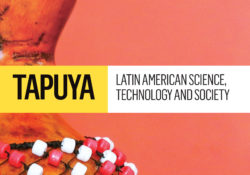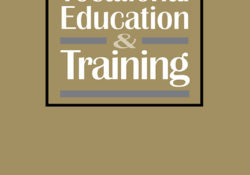eric.ed.gov har udgivet: This survey of 316 Precalculus, Calculus AB, and Calculus BC students from markedly different socioeconomic levels in four district high schools in San Antonio, Texas, looked at factors that have traditionally caused women to avoid mathematics, and attempted to discover which of them continue to influence women’s decisions to reject the discipline. The questionnaire contained 25 questions based on assumptions drawn from literature on the subject. Reported and discussed are all differences in gender opinion above 9 percentage points, even though a difference of 11.4 percentage points would begin to indicate a statistically significant result. Findings where such differences occur showed that: (1) mathematics enrollment favored men, especially in BC Calculus; (2) female respondents more frequently perceived no bias in teacher expectations; (3) female students less frequently… Continue Reading →
Like this:
Like Loading...
tandfonline.com har udgivet en rapport under søgningen “Teacher Education Mathematics”: ABSTRACT ABSTRACT This article explores the aims, strategies, developments, successes, and challenges of Gendered Innovations from its inception in 2005 to today. Gendered Innovations employs methods of sex, gender, and intersectional analysis to overcome past bias and, importantly, to create new knowledge. It seeks to harness the creative power of sex, gender, and intersectional analysis for innovation and discovery. The operative question is: does considering these factors add valuable dimensions to research? Do they take research in new directions? Gendered Innovations: (1) develops practical methods of sex, gender, and intersectional analysis specifically for natural scientists and engineers; and (2) provides case studies as concrete illustrations of how sex, gender, and intersectional analysis leads to discovery. The article discusses where Gendered… Continue Reading →
Like this:
Like Loading...
eric.ed.gov har udgivet: Many of the National Science Foundation-funded math curricula offer (or will be offering) staff development workshops to accompany the adoption of the curricula in schools and districts. While much of this staff development focuses on providing teachers with a solid grounding in the mathematical content of the curricula, an opportunity exists within these efforts to incorporate equity in a substantive way. As part of the Weaving Gender Equity into Math Reform project, we hope to provide teachers, administrators, staff developers, and others with the tools to implement themes and practices related to equity in their professions. Our project is focusing on how issues of gender, ethnicity, socioeconomic status, and language play out in the elementary reform math classroom. We plan to capitalize on staff development geared toward… Continue Reading →
Like this:
Like Loading...
tandfonline.com har udgivet en rapport under søgningen “Teacher Education Mathematics”: ABSTRACT ABSTRACT In this study, we focus on the role of Dutch Level 2 senior vocational training in care work in relation to the prospects and options it provides for students who follow this programme. Similar to the ‘care girls’ from previous studies our participants are young women from lower-class backgrounds who aspire to various jobs in the care sector, but are steered away from their original aspirations by their vocational training programme. The major difference between this research and previous studies is that we examine the Dutch institutional and broader structural context of care work. In the Netherlands, there is a lack of job opportunities for Level 2 graduates. This enables us to study the impact of limited job… Continue Reading →
Like this:
Like Loading...

tandfonline.com har udgivet en rapport under søgningen “Teacher Education Mathematics”: ABSTRACT ABSTRACT Learning intervention based on a “Mars and Space” exhibition was designed according to STEAM-education (Science, Technology, Engineering, Art and Mathematics) principles and practices in order to bridge the gap between formal and informal learning. The cognitive learning of 12-year-old students in Finland (N = 306) showed a sustained level for a six months period. The results of this study provided evidence that situational motivation was enhanced by interest in school science in the STEAM science exhibition context. This led to better cognitive learning results in the post-knowledge test. Thus, interest and situational motivation were the first steps, and the superficial situational motivation seemed to successfully change into content-based intrinsic motivation with longer-lasting, deep learning outcomes. STEAM intervention apparently produced long-term… Continue Reading →
Like this:
Like Loading...
tandfonline.com har udgivet en rapport under søgningen “Teacher Education Mathematics”: ABSTRACT ABSTRACT This article reports results of an ethnographic study of how girls are positioned, and position themselves, in relation to gender regimes in three vocational programmes in Swedish upper secondary education: Restaurant Management & Food, Health & Social Care, and Vehicle & Transport. The comparison shows that there are different possible feminine positions where the girls resist and comply to varying degrees both within and between the programmes, with expectations interrelated with discourses of consumption, caring and production. However, generally the position of emphasised femininity is most prominent and becoming a female worker in the programmes’ settings involves complying with feminine ideals of a caring discourse, regardless of whether the VET is oriented towards education for masculine production work,… Continue Reading →
Like this:
Like Loading...
tandfonline.com har udgivet en rapport under søgningen “Teacher Education Mathematics”: ABSTRACT ABSTRACT Character portrayals are important to consider when investigating the effects of educational television on young viewers. When it comes to academic interests and career aspirations, children take cues from the media representations around them. This study is a content analysis of STEM-focused children’s television shows, with attention to gender and race representation amongst the characters in those programs. Across 90 episodes of programs that claim to teach STEM to young children, 1,086 unique speaking characters were coded on demographics, physical attributes, centrality to the plot, and modeling of STEM behaviors and occupations. Following traditional industry trends, female and minority characters were underrepresented in these programs compared to population statistics. However, when it came to the centrality of their… Continue Reading →
Like this:
Like Loading...
tandfonline.com har udgivet en rapport under søgningen “Teacher Education Mathematics”: ABSTRACT ABSTRACT Adopting the interdisciplinary approach of historiography, gender history and book history, the essay sheds new light on the gendered nature of historical authorship in the late-Victorian era. By analysing how historians used such paratexts as title pages, dedications and prefaces for self-fashioning, the aim is to illustrate how paratexts contributed to the gendered idea of historical authority. As men decorated title pages with academic degrees and appointments, their title pages became symbols of scholarly excellence, strengthening the idea of history as a male preserve. Thus, it is necessary to ask how women, largely excluded from such formal qualifications, used paratexts for presenting themselves as authoritative historians. By examining the paratexts of Kate Norgate, Mary Hickson and Alice Gardner,… Continue Reading →
Like this:
Like Loading...
eric.ed.gov har udgivet: The gap among ethnicities and gender in mathematics achievement is a well-known problem. While the gap has been shrinking over the past three decades, it has not completely diminished (Jencks & Phillips, 1998; McGraw, Lubienski, & Strutchens, 2006). The ALEKS, Assessment and LEarning in Knowledge Spaces, tutoring system is one promising example of a technology that can target this problem. ALEKS is a Web-based intelligent tutoring system (ITS) that instructs students on the mathematical topics that they are most ready to learn, assesses students’ current knowledge, and evaluates student performance on problems related to those topics. In order to better understand the role that technology can play in decreasing achievement gaps for gender and ethnicity, the authors examined the effect of interacting with ALEKS in a 6th… Continue Reading →
Like this:
Like Loading...
tandfonline.com har udgivet en rapport under søgningen “Teacher Education Mathematics”: ABSTRACT ABSTRACT Research on motor learning frequently reports gender differences. However, there seems to be limited tools in the research with which to make use of these insights in educationally relevant ways. Movement learning and gender are intensely researched in movement education research, but the issues rarely intersect in the literature. The purpose of this article is to shed light on how movement learning and gender norms intersect when students learn to juggle. A pedagogical intervention in two secondary school classes (15–16 year olds) was explored ethnographically. Two composite narratives illustrate how gender norms affected the juggling practise to a different extent in the two classes, indicating that these norms are highly contextual. Learning to juggle seems to include aspects… Continue Reading →
Like this:
Like Loading...






